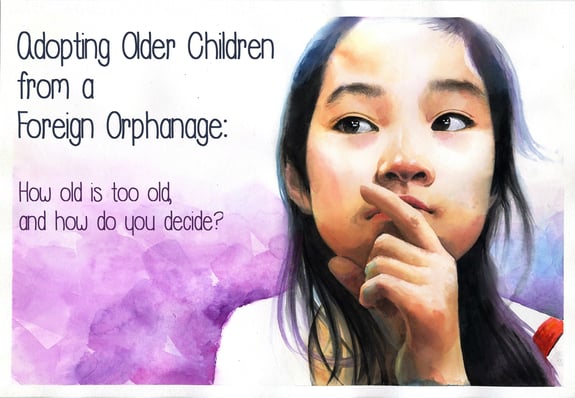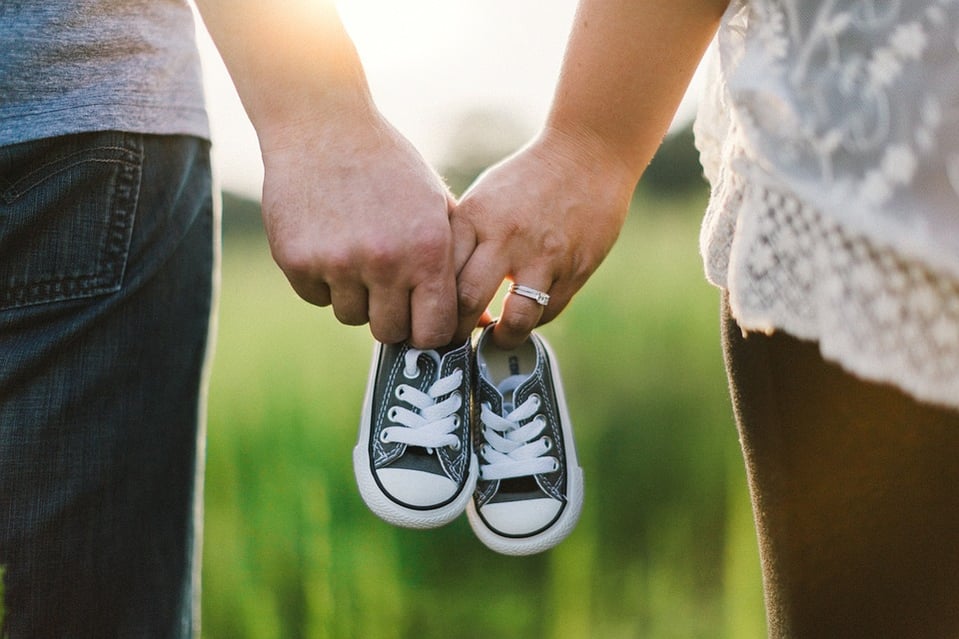How old is too old, and how do you decide?
* * *
In today’s culture, the world seems to have become a much smaller place due to the ease of travel and with the information that we can obtain from the internet. The culture has changed all over the world and while many of these changes have been positive, they have allowed us to know about situations in which many children are growing up as orphans, loosely defined in this blog as children growing up without adequate or healthy attachments to parents.

In the United States and many Western countries these orphan children are placed in foster homes with the goal of reuniting them with their parents when their parents become stable and capable of healthy attachment after receiving the help and intervention services (governmental and private). When the government/societal interventions are not successful and parental rights are terminated, the foster parents or another adoption resource create permanency for the children through adoption.
Many other countries in the world do not have the governmental infrastructure to create a foster care system and so the children in these countries whose parents cannot provide or care for them are placed in orphanages. The countries that are open to placing the children internationally when parents rights are terminated can become a resource for families in the United States to add a child to their family by adopting the children. These children are not babies. Some are young, some have special needs and some are older children (8-16 years old).
In the past twenty years or so, most of the children adopted internationally have been babies or young children adopted primarily by couples experiencing infertility issues or health issues that prevent a second pregnancy. Another common reason for the adoption of babies and young children was because a family had multiple children of a single sex and the family had a desire to parent a child of the opposite sex.
Many of the opportunities to adopt babies or young children have disappeared for Americans due to the improving social services in some countries, regulations of various U.S. & foreign governments and in some cases politics (anti-U.S. sentiments). The current opportunities adopt U.S. infants have decreased so more and more people are choosing to explore adoption of older children either through the foster care system or international adoption.
When I first started working in the field of adoption over twenty years ago, the U.S. domestic adoption culture was all about secrecy and there were no open adoptions. Today, the U.S. domestic adoption process has morphed into a culture where domestic infant placements are more often open adoptions where the adoptive parents have more social and medical information regarding their child’s birth family and where the adoptive and birth parents maintain a relationship post-adoption.
The world of international adoption is in a similar state of change today. Better social services, the availability of abortions, and cultural acceptance of pregnancy outside of marriage have created a situation where there is less need/requests for U.S. adoptive parent resources, especially for infants. In these countries both the availability of children and the age of children available has also changed. In some countries we have been made aware of the availability and of the large numbers of older children that are living in orphanages.
One of the activities that has called attention to this situation is the practice of hosting children from foreign orphanages. Many countries (China, Latvia, and Ukraine for example) are all allowing children to be hosted by Americans at winter holidays and summer holidays. When these children are hosted about 50% of families fall in love with the children and proceed to an adoption process. The children are usually eight years old and older. Some of the children are members of a larger sibling group (some younger some older) and many of the children do not have any siblings or if they have siblings, the siblings are not available for adoption.
Hosting these children and seeing if they are a good fit for your family can be a way for you to decide if you would like to adopt an older child. In all of the hosting programs you are only hosting the children to provide them with an educational and fun experience to enrich their lives. You do not mention adoption or speak to the children regarding adoption unless you have made a full commitment to these children. In some countries the child is also required to make a decision and they can choose not to be adopted. I have personally witnessed a process where a child was asked if they want to be adopted by a specific family. The process is authentic. The child is not pressured either way and has the opportunity to refuse adoption.
As an adoption professional I can tell you that adopting an older child is different than adopting a baby or a very young child because the attachment process is inherently different due to the age of the child. Being prepared for this difference and having accurate expectations of the process of attaching to an older child is a key to a successful adoption. When a couple decides to begin their family by getting pregnant what is one of the first pieces of information friends and family tell them? Be prepared for sleepless nights, interrupted sleep, etc.! Just think if no one told you that you have to be up every two to four hours at night with a newborn baby.
My first child did not sleep through the night until he was four years old. The first night he slept through the night I woke and thought he died. Seriously, I really did! None of my friends experienced this so for years I worried about him. (He’s OK- he is a Lieutenant Colonel in the air force, and happily married with three children.) The point I am making is that when you face a situation that doesn’t meet your expectations it causes anxiety, and anxiety doesn’t create a positive decision-making atmosphere. Like having biological children, there are normal expectations you can have for the adoption of older children. Even when you have reasonable expectations, there are children who are still normal and will attach and grow up fine but they sometimes have difficult behaviors that seem abnormal on the way to attachment. Adding to this is that not all behavior can be completely predictable as in the example above, but there are typical behaviors that can be predictable and ones you can prepare for mentally.
What behaviors can you expect when you adopt an older child? What are the indicators that a specific older child will fit into your family? How do you decide? Is an older child adoption a good decision for your family? I will discuss this in Part II.




Let Us Know What You Thought about this Post.
Put your Comment Below.